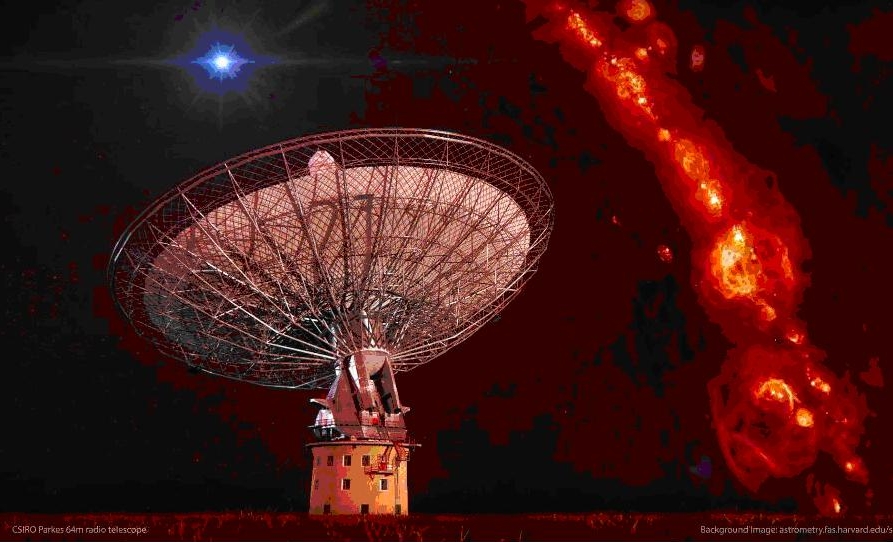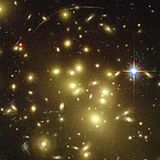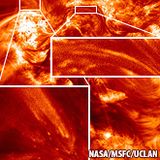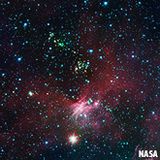

Image: CSIRO's Parkes telescope with illustration of 'radio burst' flash in the sky. The red background is gas in our galaxy. Credit: Swinburne Astronomy Productions
If you have ever been out at night and thought you saw a strange flash in the night sky, imagine the surprise of astronomers when they discovered that enigmatic flashes of energy really do happen! Using the 210 foot dish of the Parkes Radio Telescope in Australia, a group of scientists from ten institutions in Australia, the USA, UK, Germany and Italy have caught four flashes of radio energy coming from different directions - each only lasting a millisecond. These brief encounters weren't from our neighborhood, either.
By judging how the frequency was "smeared out," the researchers figure these flashes may have originated from as much as eleven billion light-years away!
"Staggeringly, we estimate there could be one of these flashes going off every ten seconds somewhere in the sky," said research team member Dr. Simon Johnston, Head of Astrophysics at CSIRO Astronomy and Space Science.
The scientists began eliminating possible sources. According to their findings, no gamma rays or X-rays were detected in association with the flashes. They have also ruled out other flash active sources such as gamma-ray bursts, merging black holes or converging neutron stars. These new flashes are an important finding, because it's not the first time it's happened.
"A single burst of radio emission of unknown origin was detected outside our galaxy about six years ago but no one was certain what it was or even if it was real," said Dan Thornton, a PhD student with the University of Manchester and CSIRO, and the lead author on the Science paper. "So we have spent the last four years searching for more of these explosive, short-duration radio bursts."
So what can they be? Right now the answer isn't clear. The original radio flash, known as the "Lorimer Burst," was also found with CSIRO's Parkes telescope. It was buried in a 2001 radio survey of the Small Magellanic Cloud and basically discovered by accident since no one was looking for a singular event.
"Finding these things requires both a sensitive telescope and spending enough time looking, and that's what we've done with Parkes," said Dr. Johnston.
According to the news release, CSIRO's Australian SKA Pathfinder telescope, now under construction in Western Australia, will be conducting a major survey for transient radio sources like the ones just found with Parkes.
"With the ability to detect these very fast sources we are opening up a whole new area of astrophysics," said Dr. Johnston.
Will we one day know the answers to what causes these mysterious flashes? Could the answer be a disintegrating black hole or a phenomenon we have yet to discover? It's very possible they will unleash gravity waves which Einstein's theory of relativity predicts - yet has never been directly observed. One thing we do know for certain: the hunt is on for the source of these elusive events.
"Pulsar surveys offer a rare opportunity to monitor the radio sky for impulsive burst-like events with millisecond durations." says the phenomenon's discoverer, Duncan Lorimer. "Hundreds of similar events could occur every day and, if detected, could serve as cosmological probes."
Original Story Source: CISRO News Release
Any guesses as to what may have caused these short-duration radio bursts? Tell us in the comments.



















